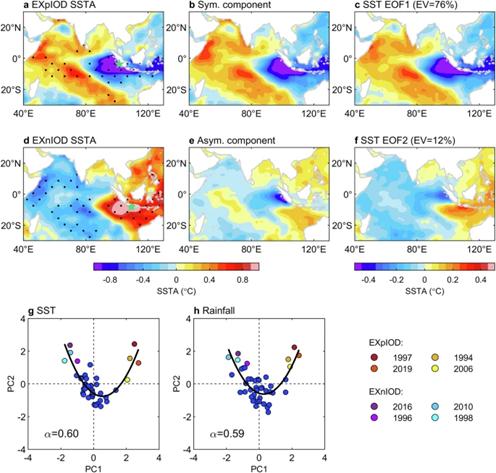Extreme Indian Ocean dipole events (EXIODs) exert pronounced climate impacts both regionally and globally, which are closely associated with their sea surface temperature anomalies (SSTAs). Here we find an evident asymmetry in SSTA patterns between the positive (EXpIOD) and negative (EXnIOD) phases of the EXIOD. Specifically, the warm SSTA center of the EXnIOD eastern pole is confined south of Java, whereas the cold pole during EXpIODs is primarily located off Sumatra. Diagnoses with model experiments further reveal that the pattern asymmetry is attributed to the non-uniformly distributed nonlinear vertical heat advection and latent heat flux anomalies along the Sumatra–Java coasts. Due to pattern asymmetry, more frequent and intense marine heatwaves and extreme sea level rise events induced by EXnIODs occur along the Java coast. However, current climate models systematically underestimate the degree of pattern asymmetry and its influences on local marine disasters, thereby challenging accurate predictions of coastal extremes.

The IOD alters the climate conditions of the TIO and surrounding continental areas as well as exerts far-reaching influences on remote regions through atmospheric teleconnections. Moreover, the repercussions of IOD events could be multifaceted, widespread and long-lasting through triggering breakouts of infectious and respiratory diseases, affecting regional and global carbon budget, and interacting with other climate modes, such as ENSO, the Indian Ocean basin (IOB) mode, and Atlantic Niño. In particular, extreme IOD events stand out from moderate ones as they impinge greatly on the hydrological and ecological cycles of the TIO-rim countries. For example, the 1997 and 2019 extreme pIOD (EXpIOD) events induced severe droughts and bushfires in Indonesia and Australia, and meanwhile brought devastating floods to parts of the Indian subcontinent and eastern Africa. By contrast, the extreme nIOD (EXnIOD) event in 2016 suppressed the East African rainfall activity during the local rainy season (October–December) to below 1 mm day−1, resulting in over 15 million people in Somalia, Ethiopia and Kenya experiencing food deficit and unsafe drinking water.
Both EXpIOD and EXnIOD have profound climatic impacts, but their associated climate anomalies are not exactly mirror images. In particular, previous studies have shown that the SSTA amplitude of the EXpIOD events is higher than that of the EXnIOD, as reflected by the positive skewness of the dipole mode index1 (DMI; see 'Methods'). As a fundamental intrinsic feature of the IOD, the amplitude asymmetry has been extensively investigated and attributed to the nonlinearity in the thermocline feedback, the shortwave radiation–SST feedback, vertical mixing and nonlinear advection processes.
Despite the overall higher amplitude of the EXpIOD compared to the EXnIOD, we found that in the Java coastal region, the observed warm SSTAs during the EXnIOD are stronger in magnitude than cold SSTAs of the EXpIOD. Along the Sumatra coasts, on the contrary, the EXpIOD SSTAs are indeed more prominent. These results suggest a pattern asymmetry of extreme IOD events—the cold pole of the EXpIOD is primarily located off the Sumatra coast, whereas the warm centre of the EXnIOD is more concentrated along the southern coast of Java, which has not been clearly identified and systematically studied. Given the prominent climatic impacts of the extreme IOD events that are closely associated with the distinct SSTA patterns, such pattern asymmetry between EXpIOD and EXnIOD holds significant implications for both Indonesia and other remote regions. Here, by combining observational analysis and model simulations, we investigate the physical causes for the pattern asymmetry and explore its coastal impacts by examining the characteristics of CHHEXs—the compound marine disaster frequently occurred in the coastal regions of Indonesia.
Sources:
Commun Earth Environ
https://www.nature.com/articles/s43247-025-02184-6#article-info .
Provided by the IKCEST Disaster Risk Reduction Knowledge Service System
Comment list ( 0 )
